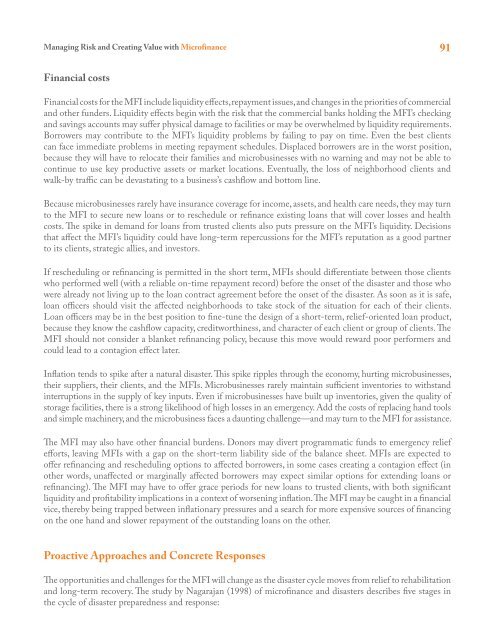managing risk.pdf
managing risk.pdf
managing risk.pdf
Create successful ePaper yourself
Turn your PDF publications into a flip-book with our unique Google optimized e-Paper software.
Managing Risk and Creating Value with Microfinance91Financial costsFinancial costs for the MFI include liquidity effects, repayment issues, and changes in the priorities of commercialand other funders. Liquidity effects begin with the <strong>risk</strong> that the commercial banks holding the MFI’s checkingand savings accounts may suffer physical damage to facilities or may be overwhelmed by liquidity requirements.Borrowers may contribute to the MFI’s liquidity problems by failing to pay on time. Even the best clientscan face immediate problems in meeting repayment schedules. Displaced borrowers are in the worst position,because they will have to relocate their families and microbusinesses with no warning and may not be able tocontinue to use key productive assets or market locations. Eventually, the loss of neighborhood clients andwalk-by traffic can be devastating to a business’s cashflow and bottom line.Because microbusinesses rarely have insurance coverage for income, assets, and health care needs, they may turnto the MFI to secure new loans or to reschedule or refinance existing loans that will cover losses and healthcosts. The spike in demand for loans from trusted clients also puts pressure on the MFI’s liquidity. Decisionsthat affect the MFI’s liquidity could have long-term repercussions for the MFI’s reputation as a good partnerto its clients, strategic allies, and investors.If rescheduling or refinancing is permitted in the short term, MFIs should differentiate between those clientswho performed well (with a reliable on-time repayment record) before the onset of the disaster and those whowere already not living up to the loan contract agreement before the onset of the disaster. As soon as it is safe,loan officers should visit the affected neighborhoods to take stock of the situation for each of their clients.Loan officers may be in the best position to fine-tune the design of a short-term, relief-oriented loan product,because they know the cashflow capacity, creditworthiness, and character of each client or group of clients. TheMFI should not consider a blanket refinancing policy, because this move would reward poor performers andcould lead to a contagion effect later.Inflation tends to spike after a natural disaster. This spike ripples through the economy, hurting microbusinesses,their suppliers, their clients, and the MFIs. Microbusinesses rarely maintain sufficient inventories to withstandinterruptions in the supply of key inputs. Even if microbusinesses have built up inventories, given the quality ofstorage facilities, there is a strong likelihood of high losses in an emergency. Add the costs of replacing hand toolsand simple machinery, and the microbusiness faces a daunting challenge—and may turn to the MFI for assistance.The MFI may also have other financial burdens. Donors may divert programmatic funds to emergency reliefefforts, leaving MFIs with a gap on the short-term liability side of the balance sheet. MFIs are expected tooffer refinancing and rescheduling options to affected borrowers, in some cases creating a contagion effect (inother words, unaffected or marginally affected borrowers may expect similar options for extending loans orrefinancing). The MFI may have to offer grace periods for new loans to trusted clients, with both significantliquidity and profitability implications in a context of worsening inflation. The MFI may be caught in a financialvice, thereby being trapped between inflationary pressures and a search for more expensive sources of financingon the one hand and slower repayment of the outstanding loans on the other.Proactive Approaches and Concrete ResponsesThe opportunities and challenges for the MFI will change as the disaster cycle moves from relief to rehabilitationand long-term recovery. The study by Nagarajan (1998) of microfinance and disasters describes five stages inthe cycle of disaster preparedness and response:
















